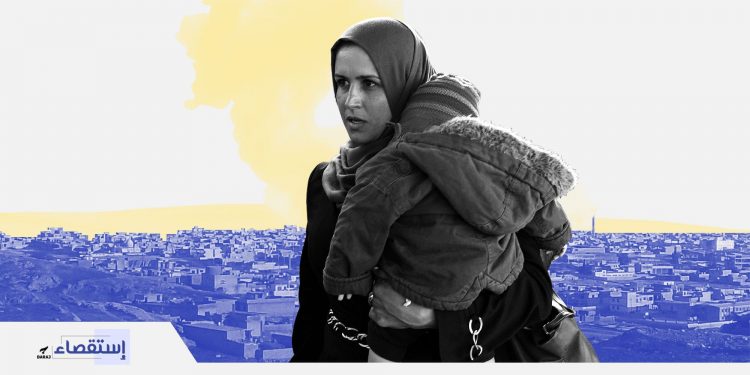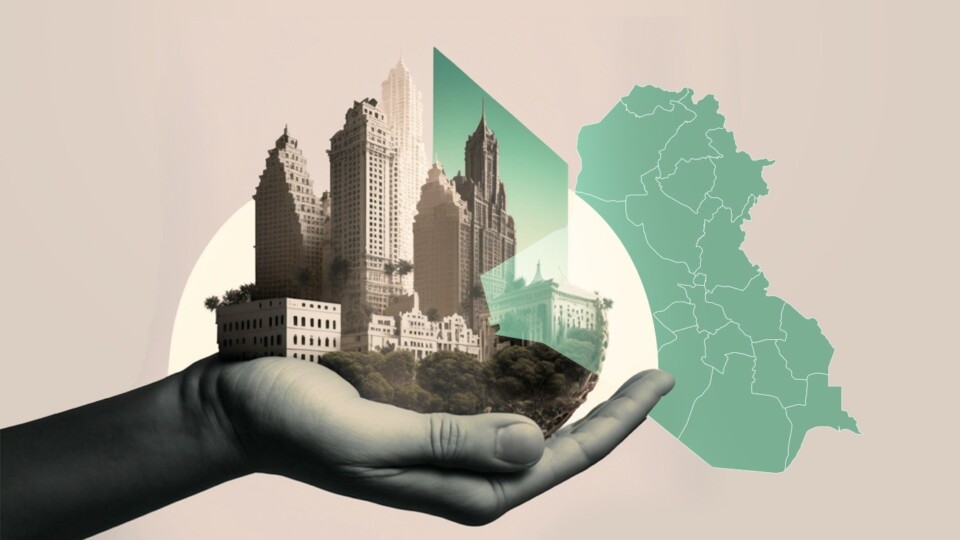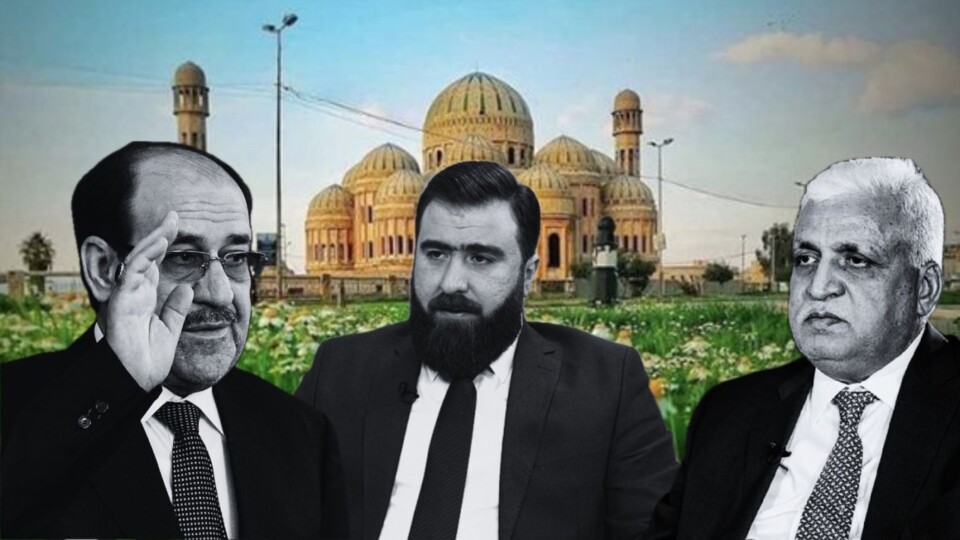

Nawzat Shamdeen
“After 70 Genocides, which we resisted and survived, we are closer today than ever to being broken and lost,” says Khadr Ali, trying to prevent himself from crying while looking at the ruins of the destroyed ancient city.
Near the entrance to the displaced persons camp in Sharya in the Kurdistan region of Iraq, the Yazidi Ikhlas Nayef (38 years old) stays for most of the day watching the faces of the entrants, hoping that among them she might find her husband and two children who were kidnapped from their home in Sinjar by ISIS fighters in early August 2014. She miraculously escaped with her baby girl.
A ritual she has been doing for more than five years, refusing to admit that they were killed, because their remains were not found in the eighty mass graves discovered in Sinjar during the past three years.
“I am sure that they are alive somewhere in Syria, and they will return one day.
Ikhlas was visiting her brother’s house in the Tal Qasab compound when “ISIS” took the area by surprise. The residents rushed to the mountains and the desert, some of them were killed while trying to escape.
Events quickly followed. Ikhlas was unable to join her husband and two young sons, Rasho and Bashar, who were at home. The wave of people fleeing to seek refuge in the mountain swept her away. Days later, she sneaked with her brother and his family across Syria into the Kurdistan region.
Since that day, Ikhlas has been waiting for her dream to come true, and for her husband and two sons to join her so they can all return to their home in the Khansour complex northwest of Sinjar. “I will keep on waiting for them … What will I do there alone with my daughter if I return now? … We do not have anyone to support us, and our house is destroyed … ”
The Tragedy of the Yazidis
The district of Sinjar, or as pronounced in Kurdish (Shankal), follows Nineveh governorate from an administrative point of view and is located northwest of it. It is one of the constitutionally disputed areas between the Kurdistan Regional Government and the federal government.
Sinjar divides a mountain bearing the same name into two parts, northern and southern, and its population is a mixture of Yazidi minority, most of whom are concentrated in the northern part, and they also spread in the southern part with villages and communities that include Sunni Arabs, while the Muslim Kurds, most of whom are Sunni, are spread in the city center, along with Shiite and other Kurdish families, in addition to Christians and Turkmen families.
According to the United Nations statistics,” ISIS” attack on Sinjar on August 3, 2014, killed 1,293 Yazidis and they kidnapped 6,417 people, more than half of them are women and children. While 360,000 were displaced to the Kurdistan region.
Atrocities were committed against the Yazidis. Yazidi women were kidnapped, enslaved and sold for years in slave markets, while hundreds of children were enrolled in ISIS training camps, and others lived with the families of ISIS fighters after their names were changed and they were taught the teachings of the Islamic religion.
Yazidi cultural and civil centers say that more than 120,000 Yazidis have migrated in recent years, following the “Genocide” they were subjected to, to European countries, most notably Germany, in the hope of starting a new life in light of the improbable chance of returning to their areas that are still in conflict with several local forces and amid the devastation inflicted on them.
Today Sinjar, which is one of the historical cities that was the hub for commercial caravans for centuries, seems almost empty of people, with no trace of life in whole neighborhoods, while silence surrounds the closed doors, with the ruins and rubble of houses built of stone and mud overlook all corners of the ancient city and its surroundings.
More than three years after its liberation from the grip of “ISIS”, the majority of Yazidis still refuse to return to what they consider their historical land.
Administrative Division and Security Conflict
Nayef Seydou, director of the North District, says that about 70,000 displaced Yazidis and Sunni Arabs have returned to Sinjar, among them 50,000 have returned to the northern part and its residential complexes. The rest refuse to return to the area, which is linked to the genocide by “ISIS”. Their homes were turned during the battles of “liberation” and the subsequent events into rubble, in the absence of reconstruction efforts.
Yazidis referred to a number of reasons that prevent them from returning to their homes, most important of which is the lack of security, the interference between forces and influential groups in Sinjar, the extent of destruction and the absence of reconstruction. Yazidis also agree that their land, with its religious shrines, is threatened today more than ever with extinction.
Khadr Ali (55 years old) says as he tries to hold his tears as he looks towards the ruins of the destroyed ancient city and behind it the mountain that extends to the west and penetrates the desert: “After 70 Genocides, which we resisted and survived, we are closer today than ever to being broken and lost.”
His colleague Hassan Muhammad (50 years) agrees: “The matter is not only related to Yazidis, but to all the people of Sinjar. It is the end of that unique coexistence that lasted for centuries between Muslims, Yazidis, Kurds and Arabs. Everything collapsed within hours at the hands of ISIS fighters,” wondering: “Who is safe today and can guarantee that his neighbor will not raid him.”
Many Yazidis and Kurds accuse their neighbors from the Arab villages surrounding Sinjar of attacking them or conspiring with “ISIS” against them, abandoning them and not protecting them. Before and during the invasion of “ISIS”, it was propagated that the Yazidis were infidels, which was considered as an excuse for their displacement, killing and captivity of their women. The bitterness of the Yazidis included some Kurdish parties that did not come to their aid to stop the “ISIS” invasion on their land.
The shadows of those divisions still cast a heavy shadow over the reality of the Yazidis in their surroundings.
Khadida Eido, a member of the dissolved Nineveh Governorate Council, says that the obsession with the security deterioration is the main reason behind the non-return of the Yazidis of Sinjar, because their areas are adjacent to the Syrian border and there is no state authority in the corresponding areas (i.e., the Syrian), in addition to their lack of confidence in the various security authorities present in Sinjar.
He says: “Yazidis repeat: Whoever left us for ISIS once, will leave us a hundred times.” referring to the rapid and sudden withdrawal of the Kurdish Peshmerga forces, which controlled Sinjar district in August 2014, after only hours of limited fighting. ISIS then imposed its control over the entire region and committed killings and kidnappings.
In a pessimistic tone, Khadida paints a picture of the current scene in Sinjar, as he describes the internal security aspect as chaotic, due to the multiplicity of decision makers with the presence of Iraqi police and army forces, in addition to the presence of PMF fighters who hold the land in the city of Sinjar and its south. On the other hand, there is the spread of the Kurdistan Workers Party (PKK) fighters and a Yazidi force led by “Haydar Sheshu” in the Kurdistan region in Mount Sinjar and some areas close to it, while the Kurdish Peshmerga spread with other armed groups in northern Sinjar.
This security reality and the multiplicity of decision-making sources led to the emergence of two administrative authorities, the first headed by Fahd Hamed, a mayor appointed by the federal government, whose influence includes the district center and its south, and a second authority headed by Muhammad Khalil, who is a former deputy appointed by the Kurdistan Democratic Party, whose influence is focused on the region North of Sinjar.
According to Khadida, this division and administrative conflict represent the biggest problem facing the future of the entire region, “no one knows when the situation will explode and a military clash will occur between the rivals,” as he put it.
Emigration Again
Yazidi activist Nadia Murad, who is a genocide and human trafficking survivor, a Nobel Peace Prize laureate and the UNODC Goodwill Ambassador at the United Nations, alerted more than once to the dangers of this conflict, and she considered it the main reason for the Yazidis’ reluctance to return or even the unwillingness of those who returned to stay. Murad reiterates in her statements that her fellow countrymen pay the price of tension and instability.
This reference to the desire of those who returned to Sinjar, to leave it again, has deepened in the last three months with the emergence of the “Corona” virus and the blocking of roads between the Iraqi provinces, which effectively led to the separation of the Yazidis in Sinjar from their displaced families in the Kurdistan region .In light of this, the food prices rose and unemployment rates escalated .
Hassan Omar, a Yazidi activist, says that dozens of his relatives in Sinjar who returned last year are planning to head again to the Kurdistan region: “Food prices have increased due to road blockings, high unemployment, and living there is no longer tolerable.”
He adds: “People there are very poor, even compared to those who live in displacement camps in the Kurdistan region, and those who return to their homes are deprived of food aid that is distributed to the camps, and this is a big problem.”
Salam Gharib, a researcher on minorities, highlights other reasons behind the reluctance of the majority of the displaced Yazidis to return, including the poor infrastructure in the district, which was completely destroyed during the war of liberation from ISIS, and the failure of the local and federal governments to implement any project for public benefit.
As for the small projects, he says that they were implemented by international organizations in partnership with local organizations linked to political parties that run them according to their preference, so some regions alone account for these projects.
He added: “As for private ownership of housing and private projects, they are 80% destroyed and none of the residents have been compensated. Rather, the central government has not formed any compensation committee for the district of Sinjar because of the dispute between it and the Kurdistan region over its management, although there are compensation committees in all the administrative units of Nineveh Governorate.
Salam adds to this what he called “the existence of multiple Yazidi decision making sources”, “The majority of Yazidis (administrative and political figures) are divided among Kurdish parties, and their demands are linked to the interests of the two main Kurdish parties, the democratic and the National Union, and they put this above the interest of the people or the region”.
(M.K.), a Yazidi activist, says that the matter is related to the financing side, and he explains: “Most of the Yazidis, due to the control of the two Kurdish parties over their areas, were linked to the two parties. Thousands of them were appointed in the Peshmerga forces and tens in the administrative units. After 2014 and with the loss of the forces’ control in the center and south of Sinjar, funding emerged from the Popular Mobilization Forces and the federal government, while some preferred to approach the PKK”.
He adds: “These intersecting parties in their interests imposed a split in the Yazidi decision, and this deepened further with the death of the former Yazidi prince in Iraq and the world, Tahseen Bey, so a new prince was chosen in the Kurdistan region who was not recognized by part of the Yazidis of Sinjar, who in turn chose for themselves a prince, while another group residing in Europe chose a third prince.
Our Dreams are becoming Nightmares
“They separated us forever on the morning of the attack on Sinjar. Within hours they turned our dreams into nightmares. We used to hear the sounds of gunshots while escaping to the mountain…These bullets killed my father and three of my brothers. My younger sister and my brother’s wife were kidnapped … I still have nightmares”.
This is how Elias Khadr (36 years old) from Sinjar city summarizes what happened to his family, ruling out the possibility of returning there again, because, he as many Yazidis believe that Sinjar is no longer viable. It is difficult to return , not only because of the devastation that took place and the lack of services, but also to the residents’ fear of repeating the tragedy that they encountered, and the fact that they lost confidence in any party that carries weapons.
On Mount Sinjar, where the Sardashti camp ,which houses thousands of Yazidis and is effectively controlled by a group loyal to the PKK, Qasim’s wife was busy preparing bread using a wood-burning oven, and around her three of her children were playing in shabby clothes. Electricity is very limited, and fuel and aid are scarce.
Qasim says that after about a year of displacement to the Kurdistan region with two of his brothers and other family members, his father died before fulfilling his dream of returning to Sinjar. “The agony of kidnapping one of our sisters and one of our brothers with his sons was too hard for him to bear, so here we are. We bear everything to be close to our land”.
In the south of Sinjar, where the Popular Mobilization Forces (PMF) control and the Federal Army is present, (AQ), who is a Kurdish Muslim, refuses to return to his village, “Qabusiye” he says: “We cannot go back and establish a new life, after we lost everything there .. Here, in the region, one of my sons works with the Peshmerga forces and others work in the construction sector .. Yes, their lives are very difficult, especially with the spread of the “Corona” virus and the interruption of salaries, but at least they are safe and not threatened. ”
He added: “In the village of Qabusiye, things are stable and safe , but who guarantees that“ ISIS ”does not renew its attack on the village which is surrounded by Arab villages and towns that for years were considered ISIS strongholds .. It is said ISSI is organizing their forces in the desert which extends to Syria … this is dangerous!”.
After months and years, feelings of suspicion and caution still prevail. “It is not only the Yazidis who have lost hope of returning. 90% of the Muslims have not returned to Sinjar. The district center included tens of thousands of Muslims, of whom only a few families have returned. In the absence of community reconciliation initiatives, everyone is afraid of everyone. When Sinjar was liberated, Yazidi groups burned homes of Muslim Kurds that were not destroyed during the battles, even though they were also victims. Killings and revenge caused terror,” says (AQ).
That reality is what makes emigration outside the country the dream of most of the Sinjaris, especially the Yazidis. One of those aspiring to immigrate is Salam, who works as a taxi driver and lives with his grandmother and younger brother in “Chamishko” camp near the city of Zakho on the Turkish border.
Salam is looking forward to traveling to Europe via Turkey through the same illegal and dangerous trafficking journeys that have led to the death of dozens of Yazidis in recent years. “There is no future for me here, nor for any of my family who are left … we have nothing left in our town to return to.”
Maysar Al-Adani, a member of the Abductees Rescue Office, reviews many reasons why the displaced Yazidis do not want to return to Sinjar: “The feeling prevails among them that assault is still continuing against them, with 2,800 kidnapped whose fates are unknown, and in the shadow of a devastated city living under the gun law.”
Al-Adani adds other reasons like the absence of any role for the Yazidi authorities in encouraging the displaced to return, the division of Yazidi politicians in loyalty between the Kurdistan region and the central government in Baghdad, the integration of the displaced into the host community and their relatively better economic conditions compared to those living in Sinjar.
Demand for International Intervention
Hissou Hormi, president of the International Yazidi Foundation Against Genocide, identifies two stages for the return of the displaced Yazidis to the areas from which they were displaced. In the first, stability is required in the Sinjar region by speeding up a true Yazidi-Yazidi reconciliation process that goes beyond mere formalities, and ending the state of division in the Yazidi community, followed by other steps to ensure coexistence with the rest of the components in the region, especially the Arab and Kurdish.
Hormi believes that sustainable peace will not be established in the Sinjar region and the Nineveh Plain without justice and real reconciliation within the frameworks of international legitimacy based on justice for the victims and respect for human rights, in preparation for the return of the people of these areas with international guarantees, such as issuing UN resolutions that oblige the Iraqi government to protect the Yazidis, otherwise the overwhelming majority of Yazidis will stick to the option of staying in displacement camps in the Kurdistan region, and postponing their return to Sinjar for an unknown period. Hormi believes that the second stage, if the return is achieved, is to activate the work of government institutions, including the elected local government, and to put an end to foreign interference in Sinjar, represented by the presence of the PKK and the Popular Mobilization Forces, and to activate the reconstruction process.
Despite the small number of returnees, there are those who have not lost hope. The fifty-year-old Yazidi, Murad Hassou, returned with his family to Sinjar a year ago, unlike his brothers and relatives who preferred to stay in the displacement camps. He has not regained his old confidence in the place and always believes that something bad will happen. But he is determined to stay, “It is our city, and we will start over there. If we all leave, others will come to take the place of our fathers and grandfathers. ”
Demographic Change
With large groups of displaced Yazidis in this atmosphere unwilling to return to Sinjar, and the fact that some of them sold their properties there, activists sounded the alarm about the future of the Yazidis’ presence in the area. Some parties issued warnings of what they describe as the systematic demographic change taking place there.
The International Yazidi Foundation Against Genocide considered that the Sinjar region is facing a hidden war in which several regional parties are participating, and appealed to the United Nations, civil organizations and the governments of Baghdad and Erbil “to stand firmly against the demographic change processes that threaten the future of Yazidis in Iraq, and affect the safe return of the displaced , civil peace and peaceful coexistence in the long run ”.
While the local administrations in Sinjar district and their authorities in Baghdad and Erbil are silent about these warnings, Yazidi citizens are reviewing their difficult choices under the obsession of what “ISIS” committed against them six years ago. Some refuse to sell their real estate and consider giving it up as a continuation of the attempts to remove them from their roots, while others find no harm in that as long as they prefer to go on with their lives elsewhere in Iraq or in Europe.
Yazidi refugee Khalil Samuqi says: “The displaced are forced to sell their properties there. They do not sell them in order to live in luxury, but because they want to survive without reaching out to seek aid from parties that are constantly trying to exploit their suffering.
Samuqi admits that their aspirations to return are getting more difficult day after day, and that increasing numbers of Yazidis are forced to sell their lands and homes today to emigrate or build a simple house in Kurdistan, which will mean, in few years, that “The dream of returning home has vanished forever “.
The report was completed with the support of the “NIRIJ” network for investigative journalism, prepared by the Nineveh Investigative Team, and published on the “Daraj” website.
Reports
Reports","field":"name"}],"number":"1","meta_query":[[]],"paged":1,"original_offset":0,"object_ids":21710}" data-page="1" data-max-pages="1">







